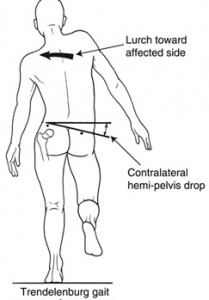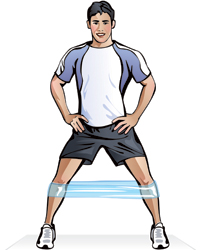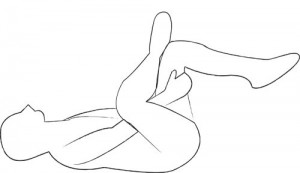
The gluteus medius has a very hard job. It provides stability of our entire skeleton when we stand on one leg, and often does this even though it is weak.
A problem that I encounter with increasing frequency in people of all ages is lateral hip pain. This has had different diagnostic labels in the past including trochanteric bursitis and snapping hip syndrome. Based on modern imaging studies, we have changed the name to account for the lack of bursal inflammation. Simply describing the area of difficulty such as lateral hip pain syndrome or the most typical pathology, gluteus medius tendinopathy, has become the new diagnostic label.
These lateral hip pain syndromes are commonly related to muscle imbalances that develop in the human musculoskeletal system. One of the most common patterns of muscle imbalance affects the hip joint. Our groin muscles known as the adductors muscles are described as being facilitated or “on”. These muscles are often maintained in a relatively shortened position, as we tend to sit and stand with our legs close together. These shortened or “on” muscles inhibit their antagonists. The antagonist muscles are known as the hip abductors. These are the muscles located in the gluteal area and they are very prone to weakness. Our sitting postures are probably the main culprit leading to weakness of these muscles.
The combination of weakness of the hip abductors and shortening of the adductor muscles has consequences in the biomechanics of walking and running. The weakness in the abductor muscles can cause excessive motion in the lower extremity and the spine. This motion can perturb pain sensitive structures.
A disturbance known as a Trendelenburg gait can develop. The Trendelenburg gait involves the left side of the pelvis falling when an individual bears weight on their right, weak side. This can cause a pinching at the front of the hip known as anterior hip impingement. It can also cause a relative sensation of tightness over the iliotibial band going across the greater trochanter, from the lateral the hip, down towards the knee. Patients can sometimes experience a snapping over the lateral aspect of their hip.

People are often concerned that they have arthritis of the hip with this lateral pain syndrome. In general, hip joint pain is experienced in the groin more than the lateral aspect of the hip. Range of motion assessment of the hip joint can usually determine whether or not a person has probable arthritis. The typical range of motion restriction is known as a capsular pattern of restriction and is normally quite evident on physical examination.
One of the risk factors that I encounter for these lateral hip pain syndromes is the presence of hypermobility of the hip. Females often have relative hypermobility of the hip, where hip internal and external rotation would total far more than 90º, the normal range of motion. In the presence of hypermobility, any weakness of the hip stabilizing musculature can cause pain and difficulties. in weight bearing activity.
If I have seen you for a lateral hip pain syndrome, we have probably gone through some of the remedial exercises that I find most helpful for this condition. In general, trunk strengthening is very helpful. Positions such as the prone plank, the supine bridge and the side plank are excellent ways to strengthen the trunk with a high degree of safety. Specific exercises to strengthen the hip abductors will usually have been prescribed. These involve some side lying exercises, known as the short leg lift and the long leg lift. The short leg lift sees the client bend the upper leg at the knee while in the side lying position. The hip is then rotated so the knee points to the ceiling. This primarily activates the gluteus medius muscle, one of the most important hip abductors. Other exercises including long leg lifts with the toes pointing down (gluteus maximus and posterior gluteals) and with the toes pointing up (tensor fascia lata and anterior gluteals) will be prescribed. More functional exercises are frequently done in the standing position. I personally use a band known as a “slingshot” to strengthen my hip abductors. Side steps, monster walks and exercises that mimic a speed skating push off are excellent ways of strengthening the hip abductor musculature.


Areas of perceived tightness are often felt deep in the gluteal region and stretches for the gluteus medius and piriformis will often be helpful. I find the figure four stretch to be the simplest to perform for most people. It helps to stretch the hip musculature known as the adductors as well as the posterior gluteals and piriformis.

I have become a fan of the use of commercially available massage balls. These massage balls are a perfect density to allow vigorous home massage of muscles that are tight and irritable. These massage balls can help to facilitate release of the muscles that feel tight. Common muscles that are irritable in these lateral hip pain syndromes include the quadratus lumborum in the low back, the gluteals and the piriformis. I encourage patients to put one of these massage balls in their gym bag so they can perform these simple personal muscle releases many times throughout the day. Foam rolling is a very good way of minimizing tissue density in the lateral hip and iliotibial band region. It is somewhat more difficult to perform and may not be appropriate for older patients or those with more significant impairments in function. Young athletes, however, greatly benefit from foam rolling multiple areas of muscle hypertonicity.

We should perform daily strength and flexibility exercise for our gluteals…for problems as diverse as back pain and knee ligament injuries.
Don’t be afraid of the Monster Walk….it is your friend.
